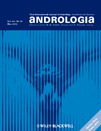Effect of spermatic vein ligation on seminal total antioxidant capacity in terms of varicocele grading
Summary
We aimed to assess the effect of spermatic vein ligation on seminal total antioxidant capacity (TAC) in patients with varicocele. Twenty infertile male patients with varicocele and 20 normal fertile men (control group) were included in the study. All the male patients were diagnosed with primary infertility and varicocele. The patients with varicocele were divided into two groups as nonpalpable (GI) (eight patients) and palpable (GII–III) (12 patients) varicocele groups. All the patients underwent microsurgical spermatic vein ligation. Seminal TAC levels and sperm parameters were evaluated in all the patients. Preoperative sperm count, sperm motility, sperm morphology and seminal TAC levels with equivalent figures 3–6 months after spermatic vein ligation and the same values of the control group were compared. There was a statistically significant increase in the total seminal antioxidant capacity level after spermatic vein ligation, and there was a statistically significant increase in the sperm count, sperm motility and spermatozoa with normal morphology. However, evaluation of the patients for varicocele grade showed a statistically significant increase in the TAC level only in the GII–III varicocele group. Spermatic vein ligation can improve the total seminal antioxidant capacity levels especially in patients with middle and high grade varicocele.




